Autonomous Driving Simulation Industry Chain Report (Chinese Companies), 2022
Simulation Research (Part II): digital twin, cloud computing, and data closed-loop improve simulation test efficiency.
Simulation tests can not only be conducted in extreme working conditions and more complex scenarios and make ADAS/ADS verification more effective, but also reproduce and generalize the real vehicle test data, allow for deeper analysis of the problems in real vehicle tests and make corresponding optimizations, speeding up function development and shortening test cycle. The higher efficiency of autonomous driving simulation tests comes with the adoption of such technologies as digital twin, cloud computing, and data closed-loop.
1. Digital twin technology will help to build more extreme test scenario combinations.
Scenario libraries are the basis of simulation tests, and digital twin technology is a powerful tool for building virtual scene libraries. To ensure the safety and reliability of vehicles, OEMs need to test almost unlimited scenarios. By referring to the real world, digital twin technology can be used to model a 3D elements library quickly and automatically, and build different roads, marking lines, weathers, surroundings and other scenarios to achieve more possible test scene combinations, thus enabling high-precision simulation of sensors, environments, vehicle dynamic models, etc. Especially in the software OTA regression testing, digital twin can also greatly improve the efficiency of simulation testing and verification.
At present, Chinese comprehensive simulation platforms like Baidu, Huawei, Tencent and Alibaba, as well as specialist simulation testing service providers such as IAE, have all used digital twin technology for scene construction.
Huawei Octopus Platform can convert the collected typical road sections into simulation scenes, and combine them with HD maps to realize digital twin of real scenes. It can not only restore more than 95% scenes, but also give great assistance to developers to quickly simulate surrounding vehicles and realize minute-level scene construction. The platform with built-in 200,000 simulation scenes can provide application tools such as simulation, scene library management, scene fragment and evaluation system, as well as high-concurrency instance handling capabilities.
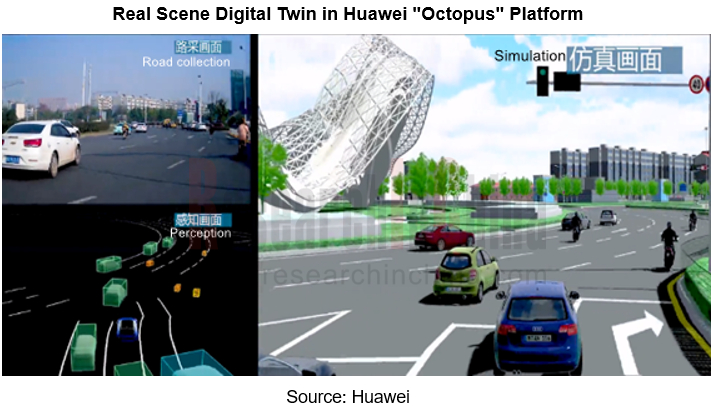
Tencent's autonomous driving digital twin simulation test platform TAD Sim (upgraded to 2.0) uses real data and gaming technology as dual-engine drive, covers simulation models such as road scene, traffic flow, vehicle sensing and vehicle dynamics, and supports OpenX and OSI international simulation standards. It offers more than 1,000 scene types, and can also generate larger-scale, rich scenes through generalization.
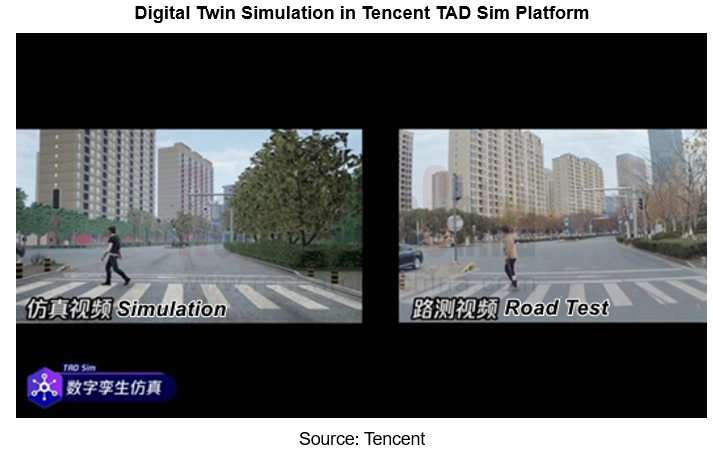
Founded in 2018, IAE is committed to building the world's largest simulation test scene workshop (massive scene libraries) with high precision, high confidence, high coverage and high freshness, and providing simulation scene data and SaaS (Scenario-as-a-Service). Its "Shuimu Lingjing" Scene Workshop is built according to the related Chinese and foreign intelligent connected vehicle industry standards, real roads and traffic behavior characteristics. With artificial intelligence and digital twin as underlying technologies, and the cross-platform and big data drive as the principle, the platform can be used to develop and build a whole-process and automated tool chain covering scene data collection, processing, analysis and mass production, realize large-scale, high-quality production of simulation scenes, and build a core support system required for large-scale algorithm training, simulation testing and evaluation. At present, IAE has built more than 8,000 groups of actually available simulation scene libraries, covering city-level digital twin, autonomous driving, Chinese and foreign regulations and standards, CIDAS traffic accident recurrence, safety of the intended functionality, and V2X.
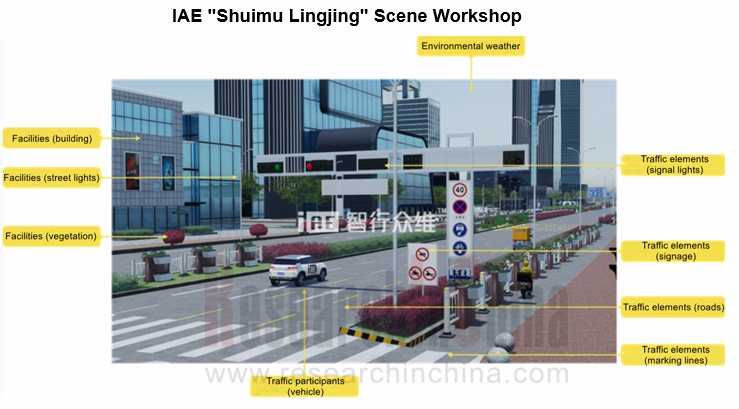

2. The simulation testing based on cloud high-concurrency operation will further improve iteration efficiency of ADAS/ADS functions.
For advanced function development and intended functionality development, the autonomous driving simulation test platform needs to offer real restoration test scenes, make good use of collected road data to produce simulation scenes, and be capable of large-scale parallel processing on the cloud, so as to answer the needs of autonomous driving for closed-loop testing of perception, decision and control full-stack algorithms. Currently, technology giants, automakers, solution providers, and simulation software companies are working to expedite the construction of virtual simulation cloud platforms.
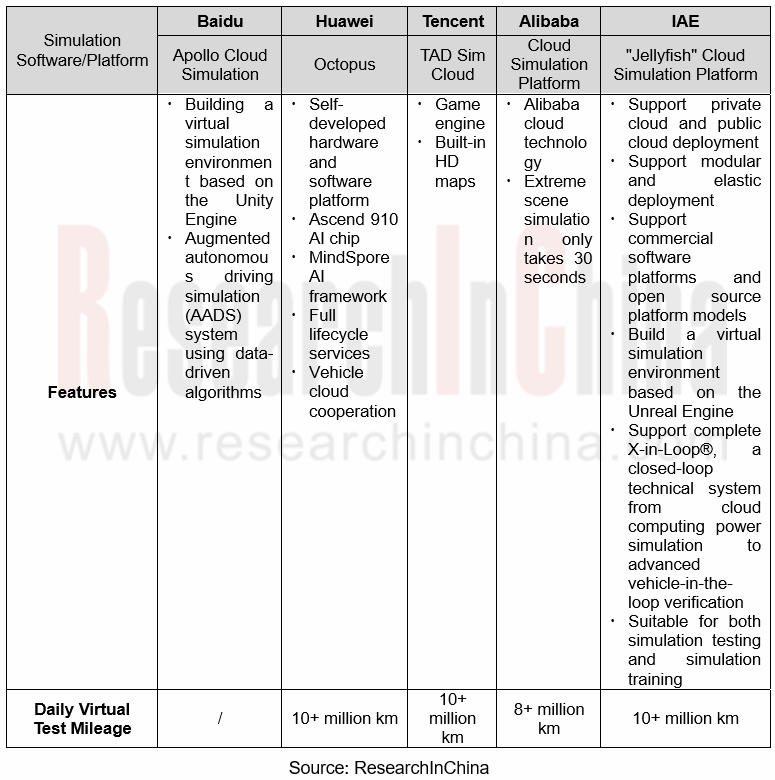
Baidu Apollo Simulation Platform is a cloud service built on Baidu Cloud and Azure. It improves the operating efficiency of simulation platforms through the large-scale distributed and dynamic variable speed simulation. Based on the large-scale cloud computing capacity, Apollo has created a virtual operating capability of millions of kilometers per day, and has built a fast iterative closed loop, making it easy for developers to achieve "millions of kilometers per day", greatly improving the development efficiency.
Alibaba Cloud Autonomous Driving Simulation Platform supports flexible, high-concurrency simulation and provides traffic flow simulation that can generate simulation traffic flows that conform to the element features and control methods of Chinese roads. Combined with autonomous driving simulation software, the platform enables game simulation, completing construction and testing of special scenes such as rainy/snowy weather and poor lighting conditions at night within 30 seconds. The Alibaba Cloud Platform favored 20 times faster autonomous driving simulation for Inceptio in 2022.
IAE "Jellyfish" Massive Simulation SaaS Platform can be deployed on private cloud and public cloud in a modular and elastic manner, and supports hypervisor, Docker and other modes. Besides designing and building cloud simulation platforms for customers, the company also builds a 400-node massive simulation SaaS platform based on proprietary cloud, with the virtual simulation test capability of daily effective mileage of more than one million kilometers, providing customers with SaaS-based simulation test services.
3. Building a data closed loop for autonomous driving simulation testing has become a new topic in the industry.
In the trend for "data-driven intelligence", simulation testing has become a key link in the autonomous driving data closed loop. How to build a data rolling iteration model through a range of simulation tests such as software-in-the-loop, hardware-in-the-loop, and vehicle-in-the-loop, and how to enable data-driven algorithm upgrades through corner cases in simulation tests have become new topics in the industry.
In March 2022, Tencent and Automotive Data of China (ADC) signed a cooperation agreement, under which data closed-loop and simulation testing for mass production becomes one of the R&D priorities.
In September 2022, IAE struck a strategic cooperation agreement with the autonomous driving industry data public service platform VDBP under the China Association of Automobile Manufacturers (CAAM). Through the close partnership with the CAAM and the VDBP platform, IAE will expand as many simulation scene data sources as possible, solve the problems of insufficient original data and single sources, and serve more Chinese and foreign OEMs relying on the platform.
In November 2022, Baidu announced a data closed-loop compliance solution for autonomous driving. Through the proprietary cloud platform, data decryption and data desensitization are carried out for simulation training, which ensures data compliance and confidentiality while implementing simulation testing.
IAE’s X-IN-LOOP simulation test technology system integrates the concepts of technology closed-loop and data closed-loop throughout the entire vehicle development and verification process, and provides complete technical solutions and services from software/hardware-in-the-loop, driver-in-the-loop, advanced vehicle-in-the-loop, and vehicle-environment-traffic-in-the-loop to digital twin scene libraries and massive cloud computing power simulations, enabling the temporal and spatial acceleration of autonomous driving R&D, testing and verification to power the commercialization of autonomous driving.
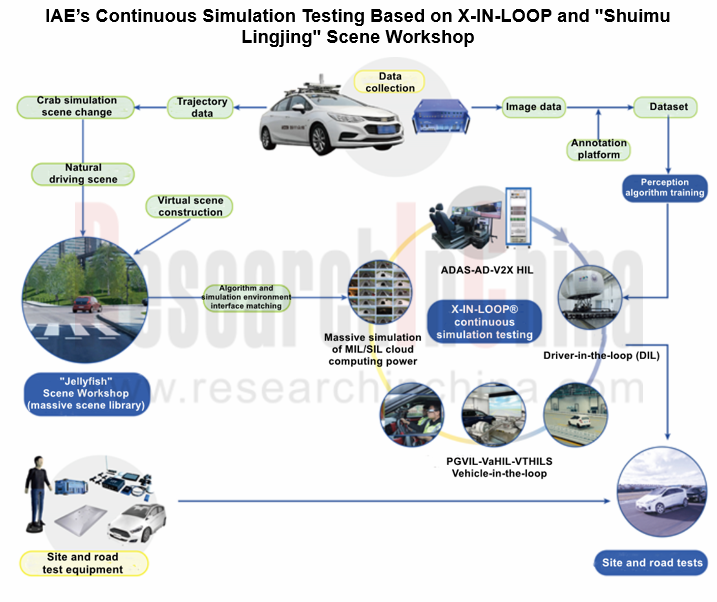
In addition, from simulation objects, it can be seen that the trend for autonomous vehicle and V2X integrated simulation is accelerating. In current simulation software, road signs, marking lines, and road facilities act as static environment elements. As vehicle-infrastructure cooperation and Internet of Vehicles technologies advance, infrastructures such as road perception and communication will participate in the interaction of driving behaviors between autonomous vehicles, and the simulation of vehicle behaviors will pose new technical requirements as urban intelligent infrastructures work.
Automotive Voice Industry Report, 2023-2024
The automotive voice interaction market is characterized by the following:
1. In OEM market, 46 brands install automotive voice as a standard configuration in 2023.
From 2019 to the first nine month...
Two-wheeler Intelligence and Industry Chain Research Report, 2023
In recent years, two-wheelers have headed in the direction of intelligent connection and intelligent driving, which has been accompanied by consumption upgrade, and mature applications of big data, ar...
Commercial Vehicle Telematics Industry Report, 2023-2024
The market tends to be more concentrated in leading companies in terms of hardware.
The commercial vehicle telematics industry chain covers several key links such as OEMs, operators, terminal device ...
Automotive Camera Tier2 Suppliers Research Report, 2023
1. Automotive lens companies: "camera module segment + emerging suppliers" facilitates the rise of Chinese products.
In 2023, automotive lens companies still maintain a three-echelon pattern. The fir...
China Passenger Car Navigate on Autopilot (NOA) Industry Report, 2023
Intelligent driving is evolving from L2 to L2+ and L2++, and Navigate on Autopilot (NOA) has become a layout focus in the industry. How is NOA advancing at present? What are hotspots in the market? Wh...
Automotive Telematics Service Providers (TSP) and Application Services Research Report, 2023-2024
From January to September 2023, the penetration of telematics in passenger cars in China hit 77.6%, up 12.8 percentage points from the prior-year period. The rising penetration of telematics provides ...
Passenger Car Intelligent Chassis and Chassis Domain Controller Research Report, 2023
Passenger Car Intelligent Chassis and Chassis Domain Controller Research Report, 2023, released by ResearchInChina combs through three integration trends of brake-by-wire, steer-by-wire, and active su...
Automotive Smart Cockpit Design Trend Report, 2023
As the most intuitive window to experience automotive intelligent technology, intelligent cockpit is steadily moving towards the deep end of “intelligence”, and automakers have worked to deploy intell...
China Automotive Multimodal Interaction Development Research Report, 2023
China Automotive Multimodal Interaction Development Research Report, 2023 released by ResearchInChina combs through the interaction modes of mainstream cockpits, the application of interaction modes i...
Automotive Smart Surface Research Report, 2023
Market status: vehicle models with smart surfaces boom in 2023
From 2018 to 2023, there were an increasing number of models equipped with smart surfaces, up to 52,000 units in 2022 and 256,000 units ...
Passenger Car Intelligent Steering Industry Report, 2023
Passenger Car Intelligent Steering Industry Report, 2023 released by ResearchInChina combs through and studies the status quo of passenger car intelligent steering and the product layout of OEMs, supp...
Automotive High-precision Positioning Research Report, 2023-2024
Autonomous driving is rapidly advancing from highway NOA to urban NOA, and poses ever higher technical requirements for high-precision positioning, highlighting the following:
1. Higher accuracy: urb...
New Energy Vehicle Thermal Management System Research Report, 2023
Thermal management system research: the mass production of CO? heat pumps, integrated controllers and other innovative products accelerates
Thermal management of new energy vehicles coordinates the c...
Commercial Vehicle Intelligent Chassis Industry Report, 2023
Commercial Vehicle Intelligent Chassis Industry Report, 2023, released by ResearchInChina, combs through and researches status quo and related product layout of OEMs and suppliers, and predicts future...
Chinese Independent OEMs’ ADAS and Autonomous Driving Report, 2023
1. Wide adoption of NOA begins, and local brands grab market share.
According to ResearchInChina, from January to August 2023, joint venture brands accounted for 3.0% of installations of L2.5 and hi...
Passenger Car Radar Industry, 2022-2023
Passenger Car Radar Industry Research in 2023:?In 2023, over 20 million radars were installed, a year-on-year jump of 35%;?Driven by multiple factors such as driving-parking integration, NOA and L3, 5...
Automotive Audio System Industry Report, 2023
Technology development: personalized sound field technology iteration accelerates
From automotive radio to “host + amplifier + speaker + AVAS” mode, automotive audio system has passed through several...
China Intelligent Door Market Research Report, 2023
China Intelligent Door Market Research Report, 2023 released by ResearchInChina analyzes and studies the features, market status, OEMs’ layout, suppliers’ layout, and development trends of intelligent...